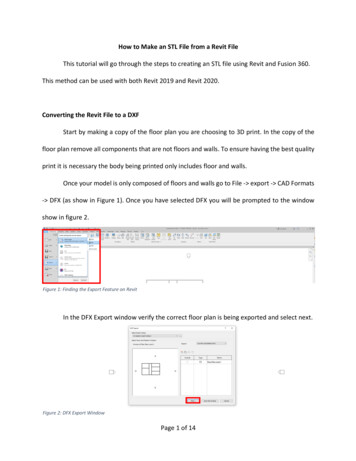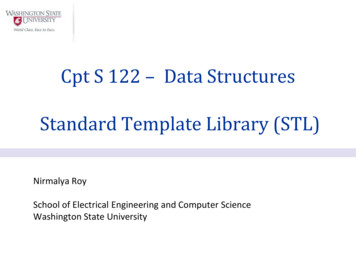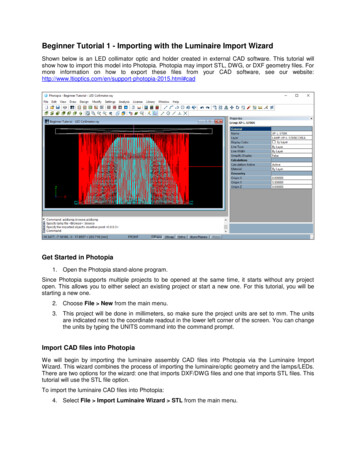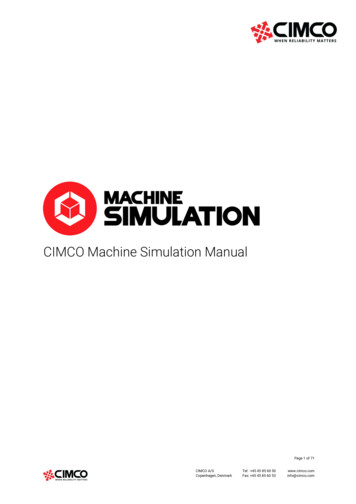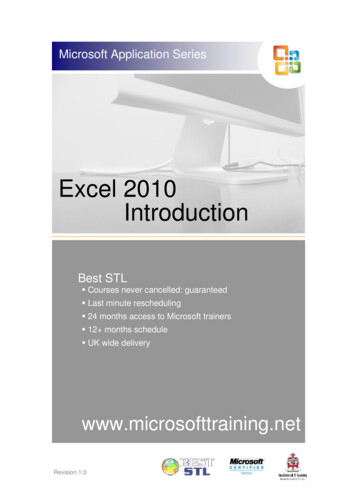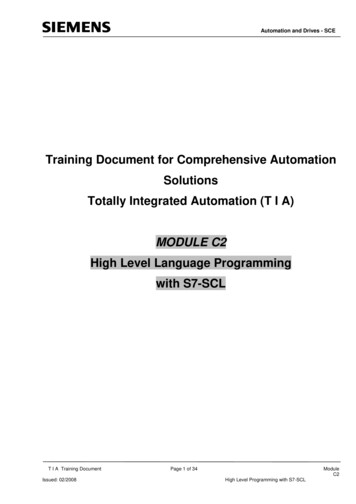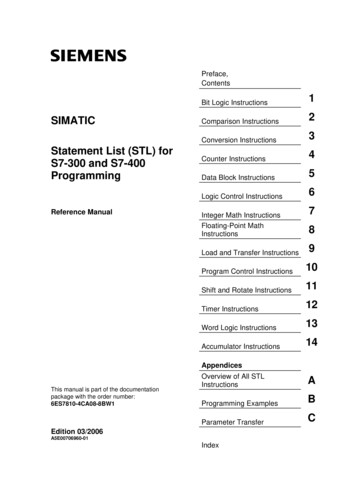
Transcription
sPreface,ContentsSIMATICStatement List (STL) forS7-300 and S7-400ProgrammingReference ManualBit Logic Instructions1Comparison Instructions2Conversion Instructions3Counter Instructions4Data Block Instructions5Logic Control Instructions6Integer Math InstructionsFloating-Point MathInstructionsLoad and Transfer Instructions789Program Control Instructions10Shift and Rotate Instructions11Timer Instructions12Word Logic Instructions13Accumulator Instructions14AppendicesThis manual is part of the documentationpackage with the order number:6ES7810-4CA08-8BW1Overview of All STLInstructionsAProgramming ExamplesBParameter TransferCEdition 03/2006A5E00706960-01Index
Safety GuidelinesThis manual contains notices you have to observe in order to ensure your personal safety, as well as toprevent damage to property. The notices referring to your personal safety are highlighted in the manualby a safety alert symbol, notices referring to property damage only have no safety alert symbol. Thenotices shown below are graded according to the degree of danger.Danger!indicates that death or severe personal injury will result if proper precautions are not taken.!indicates that death or severe personal injury may result if proper precautions are not taken.!WarningCautionwith a safety alert symbol indicates that minor personal injury can result if proper precautions are nottaken.Cautionwithout a safety alert symbol indicates that property damage can result if proper precautions are nottaken.Noticeindicates that an unintended result or situation can occur if the corresponding notice is not taken intoaccount.If more than one degree of danger is present, the warning notice representing the highest degree ofdanger will be used. A notice warning of injury to persons with a safety alert symbol may also include awarning relating to property damage.Qualified PersonnelThe device/system may only be set up and used in conjunction with this documentation. Commissioningand operation of a device/system may only be performed by qualified personnel. Within the context ofthe safety notices in this documentation qualified persons are defined as persons who are authorized tocommission, ground and label devices, systems and circuits in accordance with established safetypractices and standards.Prescribed UsageNote the following:!WarningThis device and its components may only be used for the applications described in the catalog or thetechnical description, and only in connection with devices or components from other manufacturerswhich have been approved or recommended by Siemens.Correct, reliable operation of the product requires proper transport, storage, positioning and assemblyas well as careful operation and maintenance.TrademarksAll names identified by are registered trademarks of the Siemens AG.The remaining trademarks in this publication may be trademarks whose use by third parties for theirown purposes could violate the rights of the owner.Disclaimer of LiabilityWe have reviewed the contents of this publication to ensure consistency with the hardware andsoftware described. Since variance cannot be precluded entirely, we cannot guarantee full consistency.However, the information in this publication is reviewed regularly and any necessary corrections areincluded in subsequent editions.Siemens AGAutomation and DrivesPostfach 484890437 NÜRNBERGGERMANYA5E00706960-0103/2006Copyright Siemens AG 2006Technical data subject to change
PrefacePurposeThis manual is your guide to creating user programs in the Statement Listprogramming language STL.The manual also includes a reference section that describes the syntax andfunctions of the language elements of STL.Basic Knowledge RequiredThe manual is intended for S7 programmers, operators, and maintenance/servicepersonnel.In order to understand this manual, general knowledge of automation technology isrequired.In addition to, computer literacy and the knowledge of other working equipmentsimilar to the PC (e.g. programming devices) under the operating systemsMS Windows 2000 Professional, XP Professional or MS Windows Server 2003 arerequired.Scope of the ManualThis manual is valid for release 5.4 of the STEP 7 programming software package.Compliance with StandardsSTL corresponds to the "Instruction List" language defined in the InternationalElectrotechnical Commission's standard IEC 1131-3, although there are substantialdifferences with regard to the operations. For further details, refer to the table ofstandards in the STEP 7 file NORM TBL.WRI.Statement List (STL) for S7-300 and S7-400 ProgrammingA5E00706960-01iii
PrefaceRequirementsTo use the Statement List manual effectively, you should already be familiar withthe theory behind S7 programs which is documented in the online help for STEP 7.The language packages also use the STEP 7 standard software, so you should befamiliar with handling this software and have read the accompanyingdocumentation.This manual is part of the documentation package "STEP 7 Reference".The following table displays an overview of the STEP 7 documentation:DocumentationPurposeSTEP 7 Basic Information withBasic information for technical6ES7810-4CA08-8BW0personnel describing the methodsof implementing control tasks withSTEP 7 and the S7-300/400programmable controllers. Working with STEP 7,Getting Started Manual Programming with STEP 7 Configuring Hardware andCommunication Connections,STEP 7 From S5 to S7, Converter ManualSTEP 7 Reference with Provides reference informationand describes the programmingLadder Logic (LAD)/Function BlockDiagram (FBD)/Statement List (STL) for languages LAD, FBD, and STL,and standard and systemS7-300/400 manualsfunctions extending the scope ofStandard and System Functionsthe STEP 7 basic information.for S7-300/400Volume 1 and Volume 2Order Number6ES7810-4CA08-8BW1Online HelpsPurposeHelp on STEP 7Basic information onPart of the STEP 7programming and configuringStandard software.hardware with STEP 7 in the formof an online help.Reference helps on STL/LAD/FBDReference help on SFBs/SFCsReference help on Organization BlocksContext-sensitive referenceinformation.ivOrder NumberPart of the STEP 7Standard software.Statement List (STL) for S7-300 and S7-400 ProgrammingA5E00706960-01
PrefaceOnline HelpThe manual is complemented by an online help which is integrated in the software.This online help is intended to provide you with detailed support when using thesoftware.The help system is integrated in the software via a number of interfaces: The context-sensitive help offers information on the current context, forexample, an open dialog box or an active window. You can open the contextsensitive help via the menu command Help Context-Sensitive Help, bypressing F1 or by using the question mark symbol in the toolbar. You can call the general Help on STEP 7 using the menu command Help Contents or the "Help on STEP 7" button in the context-sensitive help window. You can call the glossary for all STEP 7 applications via the "Glossary" button.This manual is an extract from the "Help on Statement List". As the manual and theonline help share an identical structure, it is easy to switch between the manualand the online help.Further SupportIf you have any technical questions, please get in touch with your Siemensrepresentative or responsible agent.You will find your contact person at:http://www.siemens.com/automation/partnerYou will find a guide to the technical documentation offered for the individualSIMATIC Products and Systems here The online catalog and order system is found under:http://mall.automation.siemens.com/Training CentersSiemens offers a number of training courses to familiarize you with the SIMATICS7 automation system. Please contact your regional training center or our centraltraining center in D 90327 Nuremberg, Germany for details:Telephone: 49 (911) 895-3200.Internet:http://www.sitrain.comStatement List (STL) for S7-300 and S7-400 ProgrammingA5E00706960-01v
PrefaceTechnical SupportYou can reach the Technical Support for all A&D products Via the Web formula for the Support equest Phone: 49 180 5050 222 Fax: 49 180 5050 223Additional information about our Technical Support can be found on the Internetpages http://www.siemens.com/automation/serviceService & Support on the InternetIn addition to our documentation, we offer our Know-how online on the internet rtwhere you will find the following: The newsletter, which constantly provides you with up-to-date information onyour products. The right documents via our Search function in Service & Support. A forum, where users and experts from all over the world exchange theirexperiences. Your local representative for Automation & Drives. Information on field service, repairs, spare parts and more under "Services".viStatement List (STL) for S7-300 and S7-400 ProgrammingA5E00706960-01
Contents1Bit Logic 3Overview of Bit Logic Instructions . 1-1A And . 1-3AN And Not. 1-4O Or . 1-5ON Or Not. 1-6X Exclusive Or . 1-7XN Exclusive Or Not . 1-8O And before Or . 1-9A( And with Nesting Open . 1-10AN( And Not with Nesting Open . 1-11O( Or with Nesting Open . 1-11ON( Or Not with Nesting Open . 1-12X( Exclusive Or with Nesting Open . 1-12XN( Exclusive Or Not with Nesting Open . 1-13) Nesting Closed . 1-14 Assign . 1-16R Reset. 1-17S Set . 1-18NOT Negate RLO . 1-19SET Set RLO ( 1) . 1-20CLR Clear RLO ( 0) . 1-21SAVE Save RLO in BR Register . 1-22FN Edge Negative . 1-23FP Edge Positive . 1-25Comparison Instructions2.12.22.32.42-1Overview of Comparison Instructions. 2-1? I Compare Integer (16-Bit). 2-2? D Compare Double Integer (32-Bit). 2-3? R Compare Floating-Point Number (32-Bit) . 2-4Conversion 23.133.143.151-13-1Overview of Conversion Instructions . 3-1BTI BCD to Integer (16-Bit) . 3-2ITB Integer (16-Bit) to BCD . 3-3BTD BCD to Integer (32-Bit). 3-4ITD Integer (16 Bit) to Double Integer (32-Bit) . 3-5DTB Double Integer (32-Bit) to BCD . 3-6DTR Double Integer (32-Bit) to Floating-Point (32-Bit IEEE-FP) . 3-7INVI Ones Complement Integer (16-Bit). 3-8INVD Ones Complement Double Integer (32-Bit) . 3-9NEGI Twos Complement Integer (16-Bit). 3-10NEGD Twos Complement Double Integer (32-Bit). 3-11NEGR Negate Floating-Point Number (32-Bit, IEEE-FP). 3-12CAW Change Byte Sequence in ACCU 1-L (16-Bit) . 3-13CAD Change Byte Sequence in ACCU 1 (32-Bit) . 3-14RND Round . 3-15Statement List (STL) for S7-300 and S7-400 ProgrammingA5E00706960-01vii
Contents3.163.173.184Counter iew of Logic Control Instructions . 6-1JU Jump Unconditional. 6-3JL Jump to Labels. 6-4JC Jump if RLO 1 . 6-5JCN Jump if RLO 0. 6-6JCB Jump if RLO 1 with BR . 6-7JNB Jump if RLO 0 with BR . 6-8JBI Jump if BR 1. 6-9JNBI Jump if BR 0 . 6-10JO Jump if OV 1 . 6-11JOS Jump if OS 1. 6-12JZ Jump if Zero. 6-13JN Jump if Not Zero. 6-14JP Jump if Plus . 6-15JM Jump if Minus. 6-16JPZ Jump if Plus or Zero . 6-17JMZ Jump if Minus or Zero . 6-18JUO Jump if Unordered . 6-19LOOP Loop. 6-20Integer Math 25-1Overview of Data Block Instructions. 5-1OPN Open a Data Block. 5-2CDB Exchange Shared DB and Instance DB. 5-3L DBLG Load Length of Shared DB in ACCU 1 . 5-4L DBNO Load Number of Shared DB in ACCU 1. 5-4L DILG Load Length of Instance DB in ACCU 1 . 5-5L DINO Load Number of Instance DB in ACCU 1 . 5-5Logic Control 26.136.146.156.166.176.186.194-1Overview of Counter Instructions . 4-1FR Enable Counter (Free) . 4-2L Load Current Counter Value into ACCU 1 . 4-3LC Load Current Counter Value into ACCU 1 as BCD . 4-4R Reset Counter . 4-5S Set Counter Preset Value . 4-6CU Counter Up . 4-7CD Counter Down. 4-8Data Block Instructions5.15.25.35.45.55.65.76TRUNC Truncate . 3-16RND Round to Upper Double Integer. 3-17RND- Round to Lower Double Integer. 3-187-1Overview of Integer Math Instructions . 7-1Evaluating the Bits of the Status Word with Integer Math Instructions. 7-2 I Add ACCU 1 and ACCU 2 as Integer (16-Bit). 7-3-I Subtract ACCU 1 from ACCU 2 as Integer (16-Bit) . 7-4*I Multiply ACCU 1 and ACCU 2 as Integer (16-Bit). 7-5/I Divide ACCU 2 by ACCU 1 as Integer (16-Bit) . 7-6 Add Integer Constant (16, 32-Bit). 7-8 D Add ACCU 1 and ACCU 2 as Double Integer (32-Bit). 7-10-D Subtract ACCU 1 from ACCU 2 as Double Integer (32-Bit) . 7-11*D Multiply ACCU 1 and ACCU 2 as Double Integer (32-Bit). 7-12/D Divide ACCU 2 by ACCU 1 as Double Integer (32-Bit) . 7-13MOD Division Remainder Double Integer (32-Bit) . 7-15Statement List (STL) for S7-300 and S7-400 ProgrammingA5E00706960-01
Contents8Floating-Point Math 910Overview of Floating-Point Math Instructions . 8-1Evaluating the Bits of the Status Word with Floating-Point Math Instructions. 8-2Floating-Point Math Instructions: Basic . 8-3 R Add ACCU 1 and ACCU 2 as a Floating-Point Number(32-Bit IEEE-FP) . 8-3-R Subtract ACCU 1 from ACCU 2 as a Floating-Point Number(32-Bit IEEE-FP) . 8-5*R Multiply ACCU 1 and ACCU 2 as Floating-Point Numbers(32-Bit IEEE-FP) . 8-7/R Divide ACCU 2 by ACCU 1 as a Floating-Point Number(32-Bit IEEE-FP) . 8-8ABS Absolute Value of a Floating-Point Number (32-Bit IEEE-FP) . 8-9Floating-Point Math Instructions: Extended. 8-10SQR Generate the Square of a Floating-Point Number (32-Bit) . 8-10SQRT Generate the Square Root of a Floating-Point Number (32-Bit) . 8-11EXP Generate the Exponential Value of a Floating-Point Number (32-Bit) 8-12LN Generate the Natural Logarithm of a Floating-Point Number (32-Bit) . 8-13SIN Generate the Sine of Angles as Floating-Point Numbers (32-Bit). 8-14COS Generate the Cosine of Angles as Floating-Point Numbers (32-Bit). 8-15TAN Generate the Tangent of Angles as Floating-Point Numbers (32-Bit) 8-16ASIN Generate the Arc Sine of a Floating-Point Number (32-Bit) . 8-17ACOS Generate the Arc Cosine of a Floating-Point Number (32-Bit). 8-18ATAN Generate the Arc Tangent of a Floating-Point Number (32-Bit) . 8-19Load and Transfer 29.139.149.159.169-1Overview of Load and Transfer Instructions. 9-1L Load . 9-2L STW Load Status Word into ACCU 1. 9-4LAR1 Load Address Register 1 from ACCU 1 . 9-5LAR1 D Load Address Register 1 with Double Integer (32-Bit Pointer). 9-6LAR1 AR2 Load Address Register 1 from Address Register 2. 9-7LAR2 Load Address Register 2 from ACCU 1 . 9-7LAR2 D Load Address Register 2 with Double Integer (32-Bit Pointer). 9-8T Transfer . 9-9T STW Transfer ACCU 1 into Status Word . 9-10CAR Exchange Address Register 1 with Address Register 2 . 9-11TAR1 Transfer Address Register 1 to ACCU 1 . 9-11TAR1 D Transfer Address Register 1 to Destination (32-Bit Pointer) . 9-12TAR1 AR2 Transfer Address Register 1 to Address Register 2 . 9-13TAR2 Transfer Address Register 2 to ACCU 1 . 9-13TAR2 D Transfer Address Register 2 to Destination (32-Bit Pointer) . 9-14Program Control 110-1Overview of Program Control Instructions. 10-1BE Block End. 10-2BEC Block End Conditional . 10-3BEU Block End Unconditional . 10-4CALL Block Call. 10-5Call FB . 10-7Call FC . 10-9Call SFB. 10-11Call SFC . 10-13Statement List (STL) for S7-300 and S7-400 ProgrammingA5E00706960-01ix
.1810.1911Shift and Rotate verview of Timer Instructions . 12-1Location of a Timer in Memory and Components of a Timer . 12-2FR Enable Timer (Free). 12-5L Load Current Timer Value into ACCU 1 as Integer . 12-7LC Load Current Timer Value into ACCU 1 as BCD . 12-9R Reset Timer. 12-11SP Pulse Timer. 12-12SE Extended Pulse Timer . 12-14SD On-Delay Timer . 12-16SS Retentive On-Delay Timer . 12-18SF Off-Delay Timer. 12-20Word Logic Instructions13.113.213.313.413.513.613.711-1Shift Instructions . 11-1Overview of Shift Instructions . 11-1SSI Shift Sign Integer (16-Bit) . 11-2SSD Shift Sign Double Integer (32-Bit) . 11-4SLW Shift Left Word (16-Bit) . 11-6SRW Shift Right Word (16-Bit) . 11-8SLD Shift Left Double Word (32-Bit). 11-10SRD Shift Right Double Word (32-Bit). 11-12Rotate Instructions. 11-14Overview of Rotate Instructions. 11-14RLD Rotate Left Double Word (32-Bit) . 11-15RRD Rotate Right Double Word (32-Bit) . 11-17RLDA Rotate ACCU 1 Left via CC 1 (32-Bit) . 11-19RRDA Rotate ACCU 1 Right via CC 1 (32-Bit) . 11-20Timer .1012.1113Call Multiple Instance. 10-14Call Block from a Library. 10-14CC Conditional Call . 10-15UC Unconditional Call. 10-16MCR (Master Control Relay) . 10-17Important Notes on Using MCR Functions . 10-19MCR( Save RLO in MCR Stack, Begin MCR . 10-20)MCR End MCR. 10-22MCRA Activate MCR Area . 10-23MCRD Deactivate MCR Area . 10-2413-1Overview of Word Logic Instructions . 13-1AW AND Word (16-Bit) . 13-2OW OR Word (16-Bit). 13-4XOW Exclusive OR Word (16-Bit) . 13-6AD AND Double Word (32-Bit) . 13-8OD OR Double Word (32-Bit) . 13-10XOD Exclusive OR Double Word (32-Bit) . 13-12Statement List (STL) for S7-300 and S7-400 ProgrammingA5E00706960-01
Contents14Accumulator .1014.1114.1214.1314.1414.15ABA-1STL Instructions Sorted According to German Mnemonics (SIMATIC) .A-1STL Instructions Sorted According to English Mnemonics (International) .A-7Programming ExamplesB.1B.2B.3B.4B.5B.6COverview of Accumulator and Address Register Instructions . 14-1TAK Toggle ACCU 1 with ACCU 2. 14-2POP CPU with Two ACCUs . 14-3POP CPU with Four ACCUs. 14-4PUSH CPU with Two ACCUs. 14-5PUSH CPU with Four ACCUs . 14-6ENT Enter ACCU Stack. 14-7LEAVE Leave ACCU Stack . 14-7INC Increment ACCU 1-L-L. 14-8DEC Decrement ACCU 1-L-L. 14-9 AR1 Add ACCU 1 to Address Register 1 . 14-10 AR2 Add ACCU 1 to Address Register 2 . 14-11BLD Program Display
Statement List (STL) for S7-300 and S7-400 Programming A5E00706960-01 iii Preface Purpose This manual is your guide to creating user programs in the Statement List programming language STL. The manual also includes a reference section that describes the syntax and functions of the language elements of STL. Basic Knowledge Required
